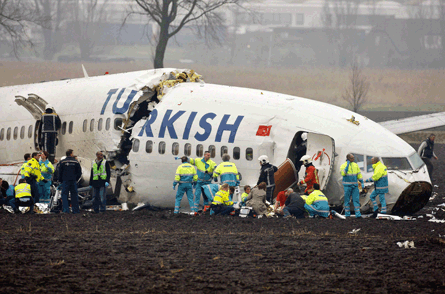Dutch investigators have concluded that an incorrect reading of the radio altimeter led a Turkish Airlines Boeing 737-800's autothrottle to command a thrust reduction in both engines to 'idle', before the aircraft crashed short of touchdown at Amsterdam Schiphol last year.
Pilots of the aircraft did not notice the autothrottle's switch to 'retard flare' mode - normally engaged below 27ft on approach - because the 737, having intercepted the localiser later than normal, at 5.5nm from runway 18R, had to descend from 2,000ft to align with the glidepath.
This descent manoeuvre, says the Dutch Safety Board, "obscured" the mode change and the aircraft's subsequent behaviour.
But the investigation also states that the aircraft's approach was not stabilised at 1,000ft, because the pilots were late in completing preparations, and that the crew should have executed a go-around.
 |
|---|
Credit: Sipa Press/Rex Features |
The right-hand autopilot continued to follow the glideslope, resulting in the aircraft attempting to maintain height with idle engine thrust. The nose-up pitch and falling airspeed eventually resulted in the aircraft's stalling - its stick-shaker activated at 460ft - and the crew failed to recover the situation in the remaining height.
Turkish Airlines normally requires both autopilots to be activated for an instrument approach. But an attempt to engage the left-hand autopilot was unsuccessful.
During the approach the first officer, who was operating as the flying pilot under supervision from a third 'safety' pilot, was using only the right-hand radio altimeter with the right-hand autopilot engaged. His displays did not register the incorrect reading from the left-hand radio altimeter, which had switched to an indication of minus 8ft.
The inquiry was unable to explain the reason for the malfunction, although it says the radio altimeter started reading incorrectly almost as soon as the aircraft took off from Istanbul.
Crucially, while the first officer was using information from the right-hand systems, the left-hand radio altimeter is the primary provider of information to the autothrottle.
The final investigation report states that this feature is a "relic" from the 737's certification in which the original design prioritised provision of information to the captain's position.
Changes in cockpit roles in the interim have resulted in pilots having an "incomplete, or even incorrect, mental model" of automated flight controls.
Although the left-hand radio altimeter was reading erroneously, the reading was not recognised as a failure, meaning there was no automatic transfer to the right-hand system. The faulty altimeter continued to feed the autothrottle, resulting in the reduction of engine thrust.
Along with the three pilots, flight TK1951 had four cabin crew and 128 passengers on board. Nine of the occupants, including four crew members, were killed in the 25 February 2009 crash.
Related links:
- Images: Turkish Airlines 737-800 incident
- Airline profile: Turkish Airlines
- Aircraft profile: Boeing 737
Source: Air Transport Intelligence news
















